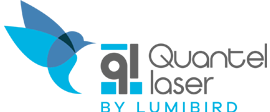The laser, that friend that comes along silently. The pulsed laser, that playful friend that appears and disappears.
The laser pulsed at nanoseconds (or "in" nanoseconds, I never know which is more appropriate), that playful friend that came to reign and that despite fads or new styles remains at the top of the sales lists. Maybe it doesn't show up in the top-40 anymore, but I don't think that Beethoven or Lee Morgan would be too bothered not to be there, rather it would offend them.
A nanosecond is 10-9 seconds, or 1/1,000.000,000 seconds.
It is so short that light only travels 30 cm in that time. It is true that there are shorter ones, ultrashort pulses call them, but perhaps not as beautiful.
Being so short, to succeed in life, he decided to appear many times, emit many pulses in a row and thus be able to increase the average power. Among other things, he invented the Q-switch, which basically consists of inserting an attenuator in the laser cavity. The attenuator rapidly switches between full and minimum attenuation, thus generating “high energy” pulses and high average lasing power. This is how our nanosecond laser arrived at typical repetition rates of kilohertz (KHz), that is, emitting more than a thousand pulses per second. It was a good idea, valid for many applications, but it was normal that the energy of each pulse was low, in the range of nanojoules (nJ) or microjoules (uJ). I remind you that the unit of energy is the joule (J) and not the watt (W), which is the unit of power.
If this type of laser is what you are looking for, write us an email with your needs and application.
But other nanosecond lasers decided instead to go the opposite way: emit few pulses, but each one of very high energies. Thus, we have repetition frequencies of hertz, tens or hundreds of hertz, but reaching tens, hundreds of millijoules (mJ) or even joules. The maximum power achievable in commercial lasers is a few joules, in case getting just a few joules seems rubbish to you, while hundreds and thousands of watts are easily achieved.
These are the lasers that we refer to fundamentally in this section: nanosecond pulsed lasers with low and medium repetition rates and high pulse energy.
We can also offer lasers that, although they emit at many picoseconds, are better called sub-nanosecond lasers.
Making a nanosecond pulse laser is actually easy. Doing it well is something else: reliable, durable, robust, easy to control, minimizing maintenance, etc… Well, this is what Lumibird-Quantel does, they are even pretty.
In this section we can offer the following catagories of nanosecond (ns) pulsed laser systems:
- compact pulsed lasers (< 1J)
- high energy pulsed lasers (> 1J)
- double-pulse lasers
- pulsed tunable lasers (OPO, dye)
Some typical applications of these nanoseconds pulsed lasers are:
| - LIBS (Spectroscopy) | - LIDAR |
| - PIV (Particle Imaging Velocimetry) | - LIF (Laser Induced Fluorescence) |
| - Materials marking and engraving | - Laser ultrasound (ultrasonics) |
| - Micromachining and materials processing | - OPO pumping |
| - Ablation | - Ti:Sa pumping |
| - Photo-acoustics Imaging | - Remote sensing |
| - Laser Peening | - Biotechnology |
| - Holography | - Medical devices |
| - Laser cleaning | |
If you prefer to continue lowering the duration of the pulse (and consequently the energy per pulse), we suggest you get to know the so-called ultrashort pulses, and thus the femtosecond lasers.
If you work with lasers, visit our sections:
- laser power and energy measurement
- laser safety and protection
- laser beam profile analyzers
We are the distributors of Lumibird (Quantel, Keopsys) in Portugal and Spain

